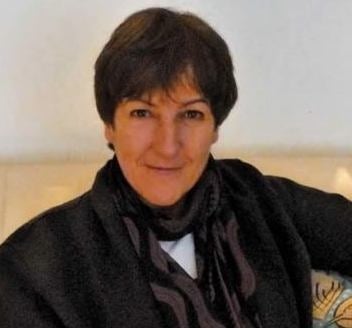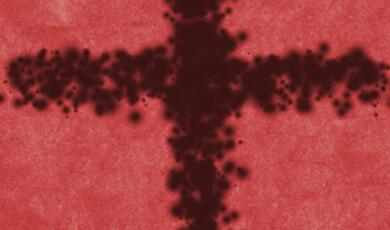30 March 2012
A Sense of the Sacred?
Professor Frances Spalding
May I begin by thanking Richard Harries for the opportunity to take part in this day event. Please beware that I am not a theologian but I hope that what follows will contribute to today’s theme. What theology I have has probably been assimilated from listening to sermons. I hope it will be enough to keep me vaguely on track, for the purposes of this talk.
We live in an age made marvellous by science and technology. Owing to the internet and globalisation we can rummage in the past, easily gaining access to images from and information about the ancient world and cultures very different to our own. There is embarrassment of riches out there, accessible by means of a few taps on an iPad, a laptop or a mobile phone. This greater reach and speed of communications can also bring us a wide-range of contacts, friends, requests, petitions, engagements, notices of forthcoming activities, etc. to such an extent that opening one’s e mail inbox increasingly becomes the main task of the day. In among all this noise and busyness, where do we go to discern the sacred, that quality or presence which stills, questions, and inspires? Ruskin found it in the brilliant blue of the gentian flower, and in peacock feathers, as you see here. But admittedly this was in part because he believed that all nature was God’s creation and therefore an expression of divinity.
Divinity may run through all things, perhaps even the internet, but the sacred, as defined by the Oxford English Dictionary, is something ‘set apart’. This implies a distance, at least psychological, if not also physical or geographical. The dictionary definition goes on to say that the sacred is dedicated for or to some religious purpose, or made holy by its association with other objects of worship; or it can also be a place or object regarded with a respect or a reverence similar to that which attaches to holy things. Something as simple, therefore, as this group of time-worn stones which, when ordered into a spiral formation, can deliver a powerful sense of attraction, its specialness arising from our deepened awareness of their shape, texture, and relatedness within the spiral pattern. In T.S Eliot’s words, ‘Only by the form, the pattern//Can words or music reach/The stillness.’ From what we have so far learnt about the sacred, it seems that it requires of the artist or craftsman and of the viewer a special form of attention; and, that though often found in a religious context, it reaches beyond that context, gathering association with objects that, however ordinary, have a special appropriateness or importance for us. It is also, I think, something, that can be associated with labour, with the making well of whatever needs making. Hence Eric Gill’s insistence that he could not begin to work until his work table was as clean and as well prepared as an altar.
Here is an instance of a work of art taking on a sense of the sacred as a result of its association with a particular place and other objects of worship. It is a four-panel painting by Alison Watt, hung in square-formation so that together they create an 8-feet-square image which hangs in mid-air over an altar in Old St Paul’s, in Edinburgh, in a side chapel, one wall of which is entirely filled with the names of those killed in the First and Second World Wars. Ostensibly, it is just another of a whole series of paintings that Alison Watt produced based on the pleats and declivities made by the folds of cream or white cloth. The starting point for this series had been her interest in the stillness and perfection in the neo-classical paintings by the French artist, J.A.D. Ingres. In St Paul’s, this subject matter, seemingly mute and devoid of narrative, invited various associations and evokes an elegiac mood. The falling movement of the cloth as it gathers into a cusp and then unfurls, carrying a reminiscence of other kinds of cloth, winding cloths, sheets or veils. It is interesting that this work was not commissioned. Instead, the artist herself, after a bout of illness, decided that she wanted to place a painting in a church, and it was only after walking around looking at various churches that she came to an agreement with Old St Paul’s for what was initially understood to be a temporary installation. But I suspect that even the artist may have been surprised by the way that associations and a sense of the sacred silently gathered round this work once it was hung in position in this grave setting. ‘So while the light fails’ – if I might be permitted to misquote T.S. Eliot, ‘On a winter's afternoon, in a secluded chapel/ History is now and Scotland (England).’
An awareness that we might be about to enter a space set apart and made sacred gives a certain tension to our struggle to open the ancient doors to churches or Lady Chapels on our sight-seeing outings. This is the door to the Lady Chapel at Long Melford, in Suffolk, one of the great ‘wool’ churches. Here, of course, even before we go inside we are aware of a great hymn to the sacred in this glorious combination of glass, tracery and knapped stone. Even small details in relatively insignificant corners of the exterior express, through craftsmanship, a reverence and respect for the building. And inside we not only find a wonderfully airy nave, as well as a new lighting system made visible in some rather stylish modern chandeliers, but also a robust set of choir seats; and inset into a side wall, an alabaster relief. This was found buried in the foundations of the church in the 18th century and it dates back to the 12th century, before the current Long Melford church was built. It surprises one into wonder, not just by its age, but through such details as the way the maid-like-angel on the left is plumping up the pillow behind the Virgin; by the way the snouts of the cows sticking out below the bed (presumably a reference to the medieval belief that the animals knelt on Christmas eve); and, most of all, by that very humane gesture of the king presenting his gift to the Christ child, for he is shown pushing up the crown on his head, as if a bit discombobulated by weariness, wonder and emotion.
Things that are set apart require us to travel in order to see them. But most religious buildings invite us to embark on a journey. Nowhere more so than here at Lincoln Cathedral. This magnificent vista, insistently axial, immediately excites. It draws us into the nave and is the start of a quest that, in liturgical terms, leads us to the High Altar. Of course, at this end of the nave we cannot see the High Altar, partly because of the screen which intercepts the flow of movement from the nave into the choir and sacristry. The medieval mass had been practically invisible, screened off at the end of the chancel at the east end, the congregation merely passive observers of priestly Latin mumming. A building of this kind presents problems today and, many would say that it ill suits modern liturgical practises. An ingenious solution has been created at Lichfield Cathedral where, again, a strong axial movement draws us towards the distant altar at the east end. But you can perhaps just see that modern choir stalls have been installed at the half way point down the nave, and in front of these is found a new pavement which can be lifted, hydraulically, so that a double stepped platform emerges from floor level to form a space for a temporary altar, the sacred ingeniously rising up out of the floor at the flick of a switch. At the heart of developments in liturgy during the 1950s and 60s, was this bringing forward of the altar in order to foreground the sacred, in an attempt to break down psychological barriers between minister and the congregation, bringing all within sight and sound of the celebration of the mass. Sometimes, as you will know, altars were permanently moved into the nave, for modern liturgy places the minister at the heart of an active congregation, the spirit now communal and vernacular.
This liturgical revolution interests me in relation to my subject as it seems to me to have sought new ways in which to express the sacred. It was most marked in the Roman Catholic Church. And as a result of the Second Vatican Council tens of thousands of altars were moved westwards so that the priest could celebrate Mass facing the congregation. One consequence of this, which cannot be denied, is that many ancient buildings suffered a degree of aesthetic vandalism. But another consequence of the Liturgical movement was a more adventurous policy of artistic patronage. After decades during which church buildings had usually erred on the side of caution and tradition, certain innovative buildings arose that set a new model for church commissioning.
A prime example is, of course, Le Corbusier’s pilgrimage chapel, Notre Dame du Haut, set atop a wild and windswept foothill of the Vosges Mountainsat Ronchamp. It was completed in 1955, and the north side is shown here.It startled many for Corbusier was of course the architect associated with functionalism, and here was a building which presented a different front on all four sides, and which employed a lyricism and poetry in the service of the church which Corbusier had once pronounced a ‘dead institution’. Yet there is no denying the intense spirituality conveyed by this extraordinary building.In the short speech which Corbusier made at the consecration of this chapel, he remarked that ‘some things are sacred and others are not sacred – whether they are “religious” or not’. Awareness that ‘religious’ content or literary association did not guarantee sacredness in art had made the man behind this commission, Father Marie-Alain Couturier, in France, determined to break with the conventional imagery within the Catholic Church and to employ artists who might not be practising Christians but whose work had integrity.
This Dominican had done much in France to set in motion the afore-mentioned adventurous policy of artistic patronage. Couturier, and Pie-Raymond Régamey had edited the influential magazine L’Art sacré from 1937 until 1954. Couturier had been responsible for commissioning work from Léger, Bonnard, Braque, Chagall, Matisse, Rouault and Germain Richier for the church Notre-Dame-de-Toute-Grâce at Assy; and he had acted as adviser for the chapel designed by Matisse for the Dominican nuns at Vence. In all these commissions Couturier upheld the principle of artistic freedom, declaring that it was better to commission geniuses without faith than believers without talent. By doing so, he succeeded in demonstrating that modern art of the highest order could be accommodated by the Church.
Couturier was aware that in Scandinavia and on the Continent new ideas about architecture and liturgy had encouraged an interest in structural clarity and a liking for bare wood and unrendered stone or concrete. Ornamentation and a conventionally religious atmosphere were being rejected in favour of a new austerity. Admittedly Ronchamp is a complex building, and externally, as mentioned, radically different on all four sides. Here is the famous south wall with its fenestration varying in size and shape. It gradual thickens in size as the wall reaches the ground. As a result these tiny slits, on the inside, become great embrasures, which act like loud speakers for the light. There is also a deliberate flash of light between the meeting of the wall and the ceiling. As a result, even when the sun is not out and the sky is overcast, the building contains explosions of light and colour, colours that vibrate against the rough, white-washed walls. It has been said of this building: ‘The total effect is of a mighty fortress, pierced by shafts of light, and creating, here the quietude of shadow, there the glowing radiance of reflection, and again the stab of intense, fiery colour. …One can only assume that, consciously or subconsciously, Corbusier meant this theme to symbolize the opening out of the human soul toward the passion and mystery of the Christian faith.’ (Albert Christ-Janer and Mary Mix Foley. Modern Church Architecture: a guide to the form and spirit of 20th century religious buildings 1962, pp.115-16). Whether or not one accepts this interpretation, there is no denying that wherever one looks the sacred is expressed by means of radical simplicity. Look, for example, at these magnificent pews made out of rough-hewn concrete and wood, at the altar and at the altar rail. In all these there is an absence of ornament or clutter, leaving the liturgical purpose of every part boldly and simply exposed.
Economic necessity alone does not explain this simplicity. It had been fired in part by the Liturgical Movement which wanted places of worship to recover the Christian qualities of poverty, humility and simplicity and become once again places of silence, reflection and prayer. This had begun to make itself felt earlier in the 20th century, at, for instance, Auguste Perret’s Notre-Dame du Raincy, in the eastern suburbs of Paris. In the early 1920s Abbé Nègre, who set about building this church, must have been a man of unusual courage. He found that the cost of building a church, big enough to accommodate two thousand people, if designed by an established ecclesiastical architect, would have cost far more than the available financial resources. So he turned to man who had never built a church before, but who had established a European reputation as a master of reinforced–concrete construction, Auguste Perret, who is on record as saying: ‘It is through the splendour of truth that a building attains beauty.’ And the result, in 1923, was a building that conveyed a sense of the scared in a new way.
It was seized on by the Liturgical Movement as a revelation as to how architecture could serve liturgy. ‘Here at last’, writes one exponent, ‘was a church of real integrity, an honest piece of reinforced-concrete construction, devoid of meretricious ornament and irrelevant detail.’ What many appreciated was the way the altar had come forward, nearer the congregation, the pillars supporting the roof had shrunk to slender rods and did not impede vision, and the walls had dissolved into a honeycomb of cement filled with coloured glass. This glass – inadequately represented in this colour slide - changes colour as one moves round the church, the east wall being an intense blue with an enormous cross outlined within the blue by means of large red dots.
Marguerite Huré’s glass was one of the things that helped steer John Piper towards his abstract design, when in the late 1950s he came to design the Baptistery window for the new Coventry Cathedral. Before setting down his ideas for this window, Piper travelled round France, looking at modern church architecture. He visited Ronchamp, also Matisse’s chapel at Vence, and he also travelled to Audincourt, a suburb of Montbeliard, where Peugeot cars are made, in order to see this early 1950s church, with stained glass in the main body of the building by Fernand Leger, and with a small baptistery attached to one side with curved walls filled with abstract stained glass by Jean Bazaine. This last surely set a precedent, as we shall see later on, for Piper’s work in the Cathedral of Christ the King at Liverpool. But in all these places Piper would have encountered a new vigour and an emblematic simplicity.
When designing the Baptistry Window at Coventry, he had initially toyed with references to the Ark, Sinai, Pentecost and the dove, but eventually he and Patrick Reytiens, the stained-glass maker with whom he collaborated, decided to abandon any representational symbol: instead the window would convey its message solely through colour; it would be colossal, theatrical and uncompromisingly abstract. Piper described his design as ‘a blaze of light, framed and islanded in colour; a blaze of light symbolizing the Holy Spirit’, but he wrote this four years after the design had been accepted. According to Reyntiens when the Bishop, Cuthbert Bardsley, asked Piper at a meeting in December 1957 if there was any symbolism in the design, Piper replied, ‘No, I don’t think there is really, apart from the idea of a great burst of light and grace.’ He found it a reward to the see the central blaze doubled by the morning sun, also to see it reflected in the shining black marble floor in cloudy weather. Under certain conditions it speckles the congregation as it gathers for a baptism round the font, the colours of the window becoming part of the liturgy. There are also certain tricks of light when the sun seems to almost enter the building. Whether or not the visitor accepts the symbolism of the light of Christ or the Holy Spirit, this sun-like effect reaches across the divisions often created by religious beliefs in its communication of regenerative, transformative power.
The Liturgical Movement was an international movement. Having begun in France in the nineteenth century, it had been influential on church building in France, Germany and Switzerland in the inter-war years. Its impact in Britain, in the post-war period, owed much to Peter Hammond, the rector of Bagendon, Gloucestershire, who had studied art before his ordination and was zealous in bringing liturgical ideas to an architectural audience. In April 1958 he published ‘A Liturgical Brief’, a provocative look at new church planning, in the Architectural Review, and followed it with two seminal books: Liturgy and Architecture(1960) and Towards a Church Architecture (1962).
I want now to show how this liturgical development impacted on an old English church. It is a small building. Here is an old photograph, taken, I think, in the 1920s - of the chancel at Tudely, three miles south of Tonbridge, in Kent. Around 1966 the local d’Avigdor Goldshmid family decided to commission stained-glass for the east window from Chagall to commemorate the death of their daughter who had died by drowning while still a young woman. As a result this small church underwent restoration at the hands of Robert Potter, architect to Chichester Cathedral and who had travelled round the continent with Peter Hammond’s books in his bag. At Chichester, he had been greatly inspired by its Dean, Walter Hussey, a famous patron of art and music, who was committed to introducing the new into ancient sacred architecture. Potter’s work at Tudely was overseen by John Piper. Together they rid the church of its Victorian clutter but retained significant items from earlier times, including a seventeenth century tomb. It seems to me that the restoration, as I hope you will see in this slide, released a powerful sense of purpose, order, calm and peace, and, in so doing, a sense of the sacred. When the Chagall window was put into position in 1968, he was so pleased with the result that he promptly offered to fill all the rest of the windows in the church. As two of these windows were already occupied by Victorian stained glass there was some opposition to this proposal and it was nine years before Chagall’s vision was achieved. This tiny church has since become a place of pilgrimage for many.
During the post-war period, with a great many churches and cathedrals in this country having been damaged or destroyed in the war, opportunities to build and rebuild churches were greater than at any other time since the Middle Ages. However most churches in this country, though hostage to a great deal of restoration in the 19th century, had, like Tudely, remained largely untouched in the first half of the 20th century. So if not moribund, they had become stuck in a style or use that related to a former age and to the liturgical practices of that age. And though England was a long way behind developments in church building that were taking place on the Continent and in Scandinavia, by the late 1950s and early 1960s there was nevertheless a sudden demand for innovation, for a breaking with conventional designs, for new ways of expressing the sacred.
A crucial ingredient in any piece of architecture is the use of light. Le Corbusier once said of his architecture – ‘The key is light and light illuminates shapes and shapes have an emotional power…’ In churches and cathedrals this use of light is often enriched or qualified by stained glass. John Piper was greatly inspired, as stained-glass designer, by a remark made by the painter Alfred Manessier, to the effect that he had come to think of stained glass, less as a design than as a ‘the simultaneous creation of a light-filled architectural unit, thought-out and created by the painter at one go’. This realisation that stained glass is inextricably bound up with architecture and light was to determine all the work that Piper produced in this medium. Diverse though his work is, it upholds his belief that ‘the function – the flesh and blood and bones of stained glass – its whole being – is to qualify light and to intensify atmosphere in a room or a building, not necessarily to provide colour or a message’.
It is by means of qualifying light that Piper helped strengthen a sense of the sacred in St Margaret’s, Westminster. This fifteenth-century church sits beside Westminster Abbey, It lost all its Victorian glass in a bomb blast in the war. Opaque bathroom glass had been installed until the War Damages Commission came up with some money, which was thought enough to restore stained glass to one window. Piper was brought in, and it seemed to him unwise to put in a single window as it would have to compete with the great east window, made in Flanders in 1501, to commemorate the marriage of Catherine of Aragon to Henry VIII. He therefore proposed a complete glazing scheme for the south aisle, some 8 windows in all. An appeal was mounted and the money raised. Piper, working with Reyntiens, devised an unaggressive screen or filter for the daylight. It modifies the light and creates a slightly grave atmosphere, aiding the sense of the scared which the setting evokes. The eight windows in no way detracts from the grand vista eastwards. Nor do they interfere with the baroque monuments that break up the wall. Despite an immediate protest that their modernity was inappropriate for the age of the building, their presence was soon forgotten, which was exactly what Piper had hoped would happen, for their purpose was not to draw attention to themselves but to engage with light and subtly alter the feel of the place.
Piper designed a great deal of stained glass, and the final example I want to give of a sense of the sacred in a building again involves stained glass, designed by him and made by Reyntiens. It also happens to be the first cathedral to break with longitudinal planning and the one that became most famous expression of the new liturgical thinking in Britain - Liverpool’s Roman Catholic cathedral, built between 1962 and 1967.
This was the third or fourth attempt to build a Roman Catholic cathedral in Liverpool. The prehistory of this building is complicated, and it was not until 1930 that a nine acre site was found, formerly occupied by a workhouse, at the top of Mount Pleasant and Brownlow Hill. This ensured that the building could be seen in relation to the Anglican Cathedral, already beginning to rise, so that two great churches would eventually crown the horizon, as we see here. In the 1930s the task of designing this cathedral was given to Sir Edwin Lutyens and we can get an idea of what he intended from his gigantic wooden model for the cathedral, now in Liverpool’s Walker Art Gallery. He wanted a dome larger than that of St Paul’s Cathedral, reaching a height of 510 feet, and a building which is size would have exceeded St Peter’s in Rome. A foundation stone was laid in 1933 and, at the wish of Pius XI, the Cathedral was re-named ‘Christ the King’. Work began on the crypt, but it was halted by the war, during which time Lutyens died. After the war the crypt was completed and brought into use, but its phenomenal size pointed up how impossible it would be to complete the original scheme, for, by 1955, the cost of building Lutyens’ design had risen from £3m to £27m, Adrian Gilbert Scott was asked to scale down Lutyens’s design and produce a compromise solution. These plans never really left the drawing board and, in 1959, by which time John Carmel Heenan (later Cardinal) had become Archbishop of Liverpool, an open competition was announced for a new Cathedral, to link with the existing crypt. The competition took place in 1960 and attracted 289 entries. The brief was for a building that would seat 2,000 people and which could be built within five years, at a cost of one million pounds in 1960 terms.
The brief was prepared before the Second Vatican council clarified the liturgical arrangements which would bring significant changes in church design. Yet already a liturgical wind of change was sweeping the altar table from the east end towards the heart of the congregation. In a letter to the competitors Heenan stipulated that the congregation had to be close to the High Altar. He wrote: ‘The High Altar is the central feature of every Catholic church. It must be the focus of the new building. The trend of the liturgy is to associate the congregation ever more closely with the celebrant of the Mass… The High Altar is not an ornament to embellish the cathedral building. The cathedral, on the contrary, is built to enshrine the altar of sacrifice. The attention of all those who enter should be arrested and held by the altar.’
The central remit was therefore now to bring out the sanctity of the altar. Frederick Gibberd, designer of London airport and Harlow New Town and with a large and prestigious practice, won the competition with a centralised plan – a circle of 194 feet in diameter which would permit some 2,000 people to gather, all within 70 feet of the central sanctuary. Lutyens’ massive crypt was retained but was roofed over, creating a platform for the new building. Gibberd recognised that the weakness of a central plan is that it lacks direction, and overcame this by placing a main axis through the building, with the Blessed Sacrament chapel at the far side, directly opposite the main entrance porch. But what earned him the assessor’s approval was the way that the building as a whole ‘powerfully expresses the kingship of Christ’, for it was designed like a crown: around its walls sixteen reinforced-concrete trusses, shaped like boomerangs, converged into a ring at the foot of the tower, creating a cone over the sanctuary before sweeping upwards to form a great, slightly-tapered lantern tower suspended over the central altar. The High Altar is therefore lit by a glazed corona, which, in shape, complements the tower of Giles Scott’s Anglican cathedral, then still under construction. It was accepted from the beginning that any material fit for its purpose would be employed, and there would be no bar on materials not previously associated with cathedral buildings. While the Anglican cathedral, begun sixty years before, crept slowly westwards stone by stone, Gibberd’s cathedral, employing techniques more often used in industrial construction, was built at speed, within four years, and was consecrated on 17 May 1967.
John Piper designed the stained glass that frames each of the side chapels as well as that which fills the lantern tower. The glass around the chapels lights the perimeters of the building. Plain glass would have rendered the interior too dependent on the atmosphere. Piper chose a blue, reminiscent of those intense blues found in 13th century glass, and green, also allowing small flecks of red to infiltrate the blue high up in a way that is said to be representative of tongues of flame.
With regard to the lantern tower, Piper and Reytiens, whom you see here painting cartoons for this tower, had just eighteen months in which to produce sixteen slightly tapering panels, each thirty feet tall and about fourteen wide. Their chosen medium was dalle de verre, a suitable tough form of glass, being an inch thick, which made concrete divisions within each section unnecessary and instead transverse divisions, horizontal bars and criss-cross reinforcements were used. Piper recognised from the start that, as the lantern was some two hundred above the floor, the effect of light and colour achieved would have to be simple in character and bold in colour. He was also aware that when the sun was at its zenith, the lantern would throw coloured light downwards, and that ‘we must enrich the whole interior without complicating it’. Lastly, he adds: ‘the lantern must act as a coloured beacon at night in the distant cityscapes of Liverpool.’
It was Reyntiens, however, who at the time was reading Dante’s Paradiso and who suggested they copy Dante and use light and colour to symbolise the Godhead. The lantern tower therefore evokes the Trinity by means of three great bursts of coloured light, blue, yellow and red. Here it is the richness of the colour that seems to evoke the sacred. This massive tower includes just over 12, 000 square feet of glass. It is not an arbitrary addition but an extension of the sanctuary: the dominant external form is over the dominant internal object, the high altar.
When it first opened in 1967, the Cathedral of Christ the King seemed radical and striking in appearance. It quickly acquired the affectionate if slightly derogatory nickname ‘Paddy’s Wigwam’. Within two decades it had begun to seem dated. By then, the centralised altar had fallen out of favour, as the problems attendant on this arrangement had begun to be felt.
Nevertheless the impact of the central space remains powerful, and the pervading blue lights which fill the strips between and around three side of each of the sixteen chapels are successfully mood-creating, in part a testimony to Piper’s lifelong fascination with the spirituality conveyed by the intense blues in medieval glass. However, in 1992 the historian John Nelson Tarn, reassessing the Cathedral, insisted that the climax of the building is still ‘high above, in the lantern, the superb, rich, jewel-like glass of John Piper and Patrick Reyntiens [that] immediately draws the eye away from nearly everything else’. But it is at night time, when lit from the inside, that it best performs its crown-like function and the ‘jewel-like colours of the glass shine out against the pale, floodlit shell.’
© Frances Spalding, 2012


 Login
Login







